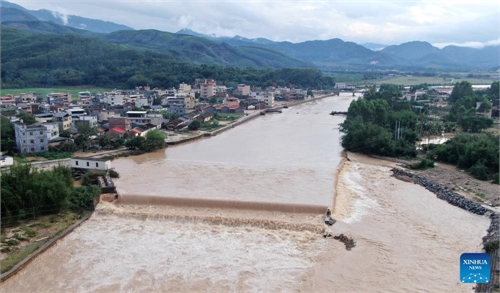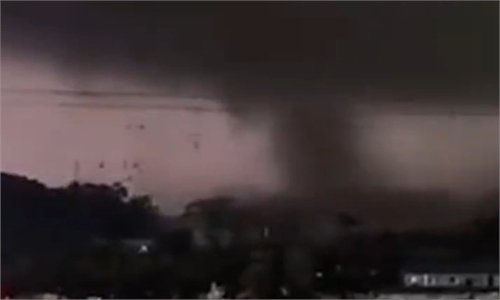
shaoguang, South China's Guangdong Province on April 24, 2024. Photo: IC
Convective weather in South China's Guangdong Province will continue over coming days, a local meteorological observatory said on Sunday following a powerful tornado on Saturday striking a district in Guangzhou resulting in five deaths and 33 injuries. Meteorologists attributed the convective weather to impact caused by global warnming."During recent days, when a heavy rain falls, the sky always suddenly darkens, making it seem like night during daylight. It's kind of scary," Xiaoli, a resident living a Guangzhou's Haizhu district, told the Global Times.
Due to continued rainfall in Guangzhou, Xiaoli noticed that thin water-proof shoe covers are becoming more popular. "Many people around me take those shoe covers wherever they go. The rain in the city is just always on and off. You would never predict when it is going to really coming down."
The Guangzhou Meteorological Observatory predicts that over coming days, Guangzhou, the capital city of Guangdong, will experience frequent severe convective weather, including hail and tornadoes, short-term downpour, strong thunderstorms, and gusts.
From Sunday to Monday, influenced by high-altitude fluctuations and southward airflow, the local meteorological observatory predicted there is a high probability of severe convective weather in Guangzhou, with heavy rain and localized heavy rain, mainly arriving in the afternoon. On Tuesday, affected by cold air, shear lines and high-altitude troughs, Guangzhou will still experience severe convective weather, with heavy rain and localized heavy rain.
Currently, the city of Meizhou and the eastern part of Guangdong are also still experiencing heavy rainfall. At the time of reporting, an orange storm warning remains in effect for 14 cities and counties, including Shanwei, Shantou, and Jieyang.
Heavy rainfall in Guangdong Province made national headlines after a powerful tornado on Saturday struck a district in Guangzhou. Around 3 pm on Saturday, the tornado hit the Baiyun district, impacting an area approximately one kilometer wide and affecting four villages.
China Weather issued a statement that on Saturday afternoon, Guangzhou was experiencing violent convection weather, many places fell hail, according to photos posted by netizens show that the largest hail as the size of an egg.
From Saturday onwards, influenced by the eastward movement of the upper-level trough and the convergence of low-level shear, a mixed type of severe convective weather has been observed in the eastern part of the southwest region, central and eastern parts of the regions south of the Yangtze River, and South China, meteorologists said.
Since the beginning of this year, China has experienced 13 severe convective weather events, or known as severe storms or extreme storms in the West. The increasing frequency and intensity of extreme weather events could attribute to global rise in temperatures, Sun Shao, a senior researcher at Chinese Academy of Meteorological Sciences, told the Global Times on Sunday.
Historical observations show that for every 1 degree increase in sea temperature, the frequency of severe convective events increases by 20 percent. A model created by Sun indicates that as temperatures continue to rise in the future, the frequency of severe convective events will continue to increase.
Changes in Earth's climate system impact atmospheric water vapor content. Warming climates boost surface and ocean evaporation, elevating water vapor levels and fostering severe convective weather. Climate change can also modify atmospheric circulation, potentially intensifying cyclone and front formation, further fueling severe convective weather, according to Sun.
The meteorological department reminds that it is necessary to continue to put in place measure for the prevention of heavy rainfall and its secondary disasters such as flash floods, mudslides, landslides, collapses, urban and rural flooding and small- and medium-sized river floods.



